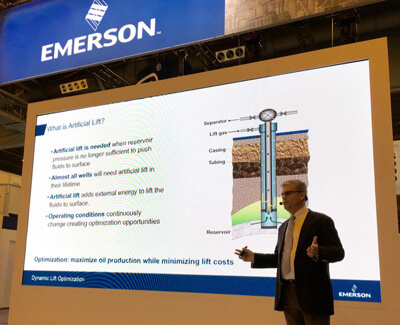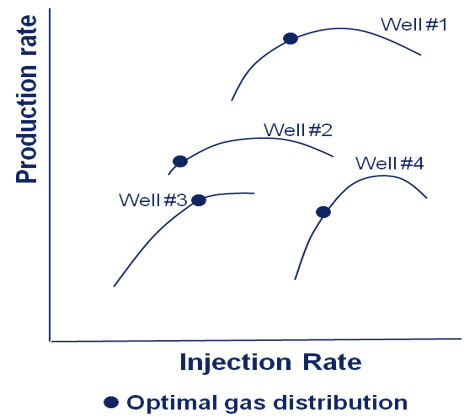In these current times of lower oil prices, operational efficiency is a top priority along with cost control for oil and gas producers. The challenge is to maintain base production levels and extend & stem the decline rate of producing wells. Most wells require artificial lift methods such as gas lift and water flood.
 Emerson’s Darren Doige described the goal of optimization around artificial lift methods to maximize oil production while minimizing lifting costs. Traditionally gas lifting was a manual operation. Optimization was based on trial and error, which took time and did not account for changes in the reservoir that may have impacted production rates. Overall, there was a lack of insight into current well production levels. Manually adjusting gas lift flow rates cannot be done in real time in response to well variability.
Emerson’s Darren Doige described the goal of optimization around artificial lift methods to maximize oil production while minimizing lifting costs. Traditionally gas lifting was a manual operation. Optimization was based on trial and error, which took time and did not account for changes in the reservoir that may have impacted production rates. Overall, there was a lack of insight into current well production levels. Manually adjusting gas lift flow rates cannot be done in real time in response to well variability.
As a result, oil and gas producers are unable to meet their production targets and more effectively distribute the required artificial lift energy to most profitable wells. The most economically optimal production rates are not achievable through a manually controlled approach to gas lifting.
 From a process control strategy standpoint, the oil production output from a well is a non-linear function of the lift energy put into the well. At low rates, the oil production increases with lift energy rates. At high rates, oil production decreases because of the increase of backpressure in the flow system. Now, when you consider the challenge in optimizing multiple wells—each with its own constraints, the optimization challenge grows greater. Each well has optimal gas injection rate based on current production levels.
From a process control strategy standpoint, the oil production output from a well is a non-linear function of the lift energy put into the well. At low rates, the oil production increases with lift energy rates. At high rates, oil production decreases because of the increase of backpressure in the flow system. Now, when you consider the challenge in optimizing multiple wells—each with its own constraints, the optimization challenge grows greater. Each well has optimal gas injection rate based on current production levels.
Common constraints include the gas compressor size and generated kW required for the lift gas, the production facility separation capacity and the water handling and disposal capacity. Any optimization must also system disruptions caused by equipment outages, well slugging, well workovers and shut-ins and production minimums.
Through additional measurements and applications, oil and gas producers can have real-time measurements of well production rates, a better understanding of the platform’s or well pad’s process constraints, better regulation and apportionment of lift gas, and recordkeeping to manage and report on changes.
For one offshore oil & gas producer who was challenged with a limited supply of lift gas, dynamic lift optimization was applied to use the lift gas on the most profitable well and inject at their optimum production levels. The entire field of 5 platforms and 38 wells were modeled to consider that the gas and facility constraints. The production performance of these is monitored in real time, allowing production deviations to be addressed more quickly. Overall, they achieved better than a 10% production increase across the entire field.
If you’re in Houston today for the 2016 Offshore Technology Conference (OTC), make sure to speak with our produced fluids management experts. Register to receive a complementary OTC day pass for more on this and other oil and gas solutions.
You can also connect and interact with other oil and gas experts in the Oil & Gas group in the Emerson Exchange 365 community.
